New York Grown Oranges!
Yes, A True Citrus
Oranges? In New York, planted outdoors in the ground? Yes, I have them ripening on the branches now. No matter if they ripen thoroughly or not because, although they are true oranges, delicious flavor is not one of their assets. It’s still a plant well worth growing.
The plant is the aptly named “hardy orange,” actually a true citrus species, Citrus trifoliata. (Previously, hardy orange was a citrus relative; botanists recently moved it to the Citrus genus from the closely related Poncirus genus.)
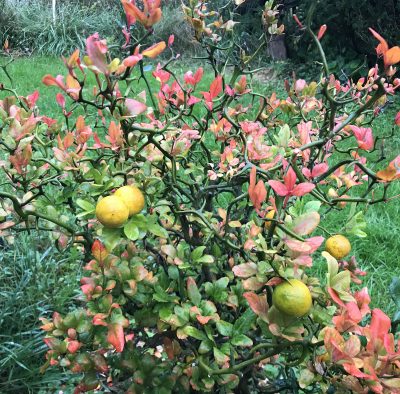
Mostly I planted hardy orange for its stems, whose show is at the same time intimidating, interesting, and decorative. Stems of the variety that I grow, Flying Dragon, twist and contort every which way, and then add to the show with large, recurving thorns. Stems and thorns are forest green, even as they age, and remain so all through winter to make the plant especially decorative when leafless.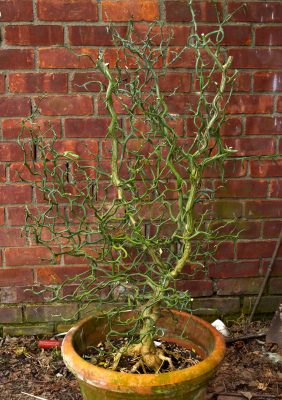
I would have planted Flying Dragon hardy orange just for its stems. But adding to the show, in spring are white flowers — citrus flowers — that are fragrant just like those of oranges and lemons. On my plant, at least, they’re smaller with commensurately less fragrance.
This year, this month, Flying Dragon has presented yet another attractive face. Its leaves are preparing to drop by turning a pinkish crimson. This color, developing for now on leaves towards the ends of the topmost branches contrasts nicely with the still forest green leaves and the few fruits starting to yellow.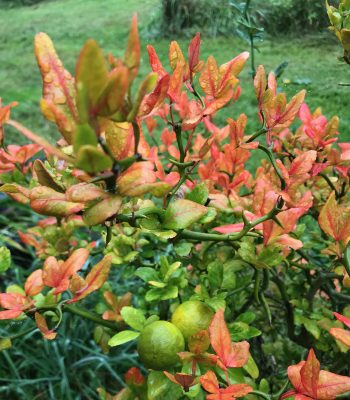
The problem with the fruits, gustatorily, is that they’re not very juicy, and they are very tart, somewhat bitter, and seedy. Still, they can be used to add a bit of home-grown citrus flavor to an -ade (Flying Dragonade?), fish, etc.
I Plant A Seed
New hardy orange plants are easy to raise from seed. The most important ingredient, as with other citrus, is not letting the seeds dry out once extracted from the fruit.
With most plants, you don’t get an exact replica of the mother plant in seedlings. Plant a McIntosh apple seed and the resulting tree will not bear McIntosh apples. (Just as you are not a genetic replica of your mother.) It depends on what pollinated the mother tree and how the chromosomes sorted out. Even though peaches are self-pollinating, the offspring of a Redhaven peach won’t bear Redhaven peaches.
Plant a seed of Flying Dragon hardy orange (or some other citrus varieties, in general), and you could get more Flying Dragons, exact replicas of the mother plant. That’s because citrus are among the few plants that exhibit apomixis, that is, seeds within the fruits that develop from only mother plant tissue.
Other plants that also bear apomictic seeds are some species of onion and dandelion. Some coneflowers, apples, and raspberries also bear apomictic seeds, but only if the flowers are pollinated — even though the pollen does not insinuate itself into the apomictic seed’s genetics.
Not all the seeds within a Flying Dragon fruit are apomictic. Hence, not all will grow to become Flying Dragons.
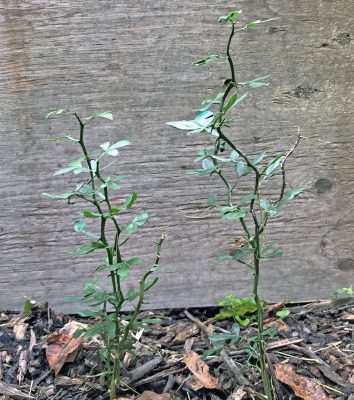
The seedling on right is probably apomictic
Further complicating matters, some seeds can develop into more than one seedling! And some of those seedlings growing from that one seed might be apomictic while others will be run-of-the-mill.
None of these complications interferes with my propagating Flying Dragons from seed. The contorted stems and recurved thorns are so distinctive that it’s easy to tell the Flying Dragons from the others. Apomictic seedlings also are generally more vigorous than sexually-produced seedlings.
Not Everyone’s A Fan
Southerners are not nearly as enamored with hardy orange as I am . The hardiness, the thorns, and the seeds’ enthusiasm to sprout make the plants a threat down there, where the shrubs grow from 8 to 15 feet tall.
Hardy oranges were introduced into the south about 150 years ago, possibly to contain livestock. There, the plants have spread to woodlands, forest edges, and fencerows to shade out native plants. The lack of affection for the plant might be summed up in a quote from a Texas publication stating that hardy orange “does respond well to bulldozing.”
While bemoaning not being able to grow southern magnolia, gardenia, camellia, and crape myrtle this far north, I am thankful for being able to grow hardy orange without any danger.


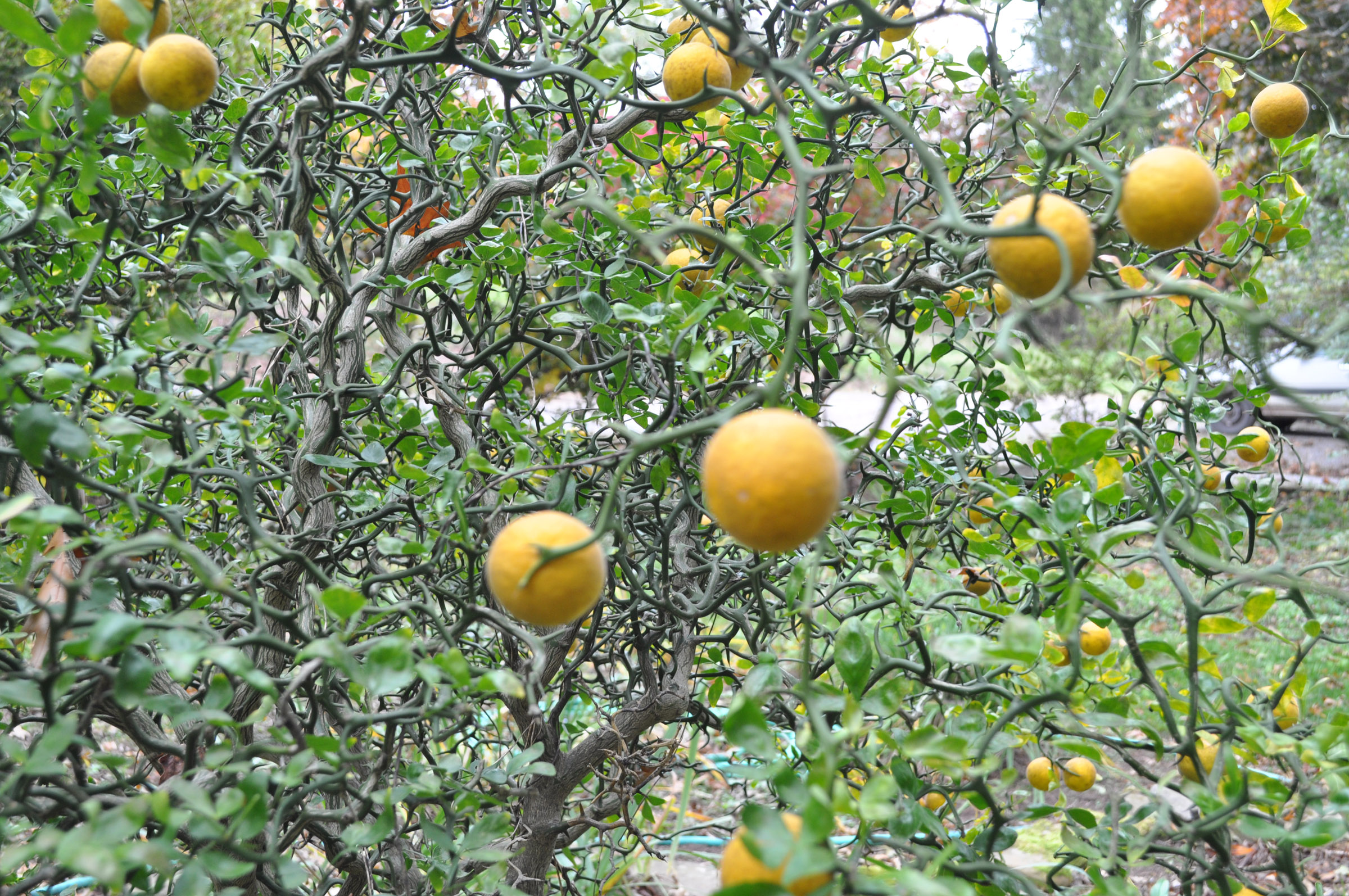

So you plant this right in the ground outside? And the plant will survive the winter?
I’m in Greene county, NY, would I be able to do that? I find the plant fascinating.
I grow lemons and limes but keep them in a pot and bring them in over the winter, I would love to be able to have a citrus that I can keep outside.
Hardy orange is hardy to zone 5, where lows drop to about minus 15°F.
Love this! Selling those hardy orange seedlings next May? Say it’s so.
Yes, it is so.
Where do you get the seeds or plants to buy
..And do they last through winter.Any precautions.
J.L. Hudson sells seeds. Many places sell plants. Just search for either Poncirus trifoliata or Citrus trifoliata. Mine have been hardy here in Zone 5 although winters have not been as cold as in the past, often hardly dropping below zero degrees F.
Thanks Lee! I use orange peels soaked in vinegar to make an orange cleaning spray, and I wonder if these oranges would serve well for this purpose, given their thick resinous rinds.
Probably
I grew hardy orange for years down in Old Lyme, CT. It was a stunning specimen in all seasons, and, happily, totally deer proof. I was never able to detect any fragrance from the blossoms, although I was always too afraid to stick my nose too close to them, due to those terrifying thorns.
Hi Lee! Love reading your articles- still have to get in one of your workshops! This year the dates just didn’t work out for me!
Please let me know about your ‘ growing blueberry workshop’ as soon as you have planned the dates for it so I can plan on attending; thanks!
Just curious – have you tried planting figs or persimmons?
Thanks, glad you like them. As far as planting figs or persimmons: Yes! I’ve grown both in variety for many, many years. Put “fig” or “persimmon” in the “search” box on my blog page and you’ll find numerous things I’ve wrote about my fig and persimmon plants.
When is the best time to pick oranges? Color? Month? If they are marbled in green and orange can they rippen picked? Is there a way to to make them sweet and juicy?
Citrus fruits pass from immature to mature and finally to an over mature condition while remaining on the tree, but the changes are slow and spread over several months. The best way to know when to harvest is to taste the fruit. Fruit color is a poor indication of ripeness, because many fruits have fully colored rinds a long time before they can be eaten and some fruit are green when the sugars are high enough to make a delicious tasting citrus. The fruits will not further ripen after being picked. The fruits store best on a tree so leave the there rather than plan to pick them all and eat them gradually fro storage.
Hi Lee, enjoy your posts, when is the best time to prune lime trees, before flowering or after? Thanks for the other information
Prune early-flowering trees and shrubs right after they bloom. Prune later-flowering trees and shrubs before growth begins, while plants are dormant.
Aloha,
I am growing flying dragon rootstock and they have all started to turn a yellow red color the same as in your pictures… Is this normal?
I am very worried something is wrong..
Hi, I received your voicemail last night about reddening of poncirus leaves. I believe that’s just a precursor to the leaves dropping in fall. In Hawaii, you have neither the daylength nor the cold to quickly force dormancy so the leaves might turn red more sporadically. My guess is not too worry. My plants seem fine even though I don’t think they go through that red leaf stage every year before leaf drop.
Is this plant related to the native osage orange?
Not at al related. Osage orange is related to mulberry and fig, but is not edible. The hardy orange is in the Citrus genus along with oranges, lemonsm and other citrus.
Hi,
I just planted several flying dragon in the ground that I started from seed late last winter. I’m in southern Iowa 5b. What would be your suggestions on helping them make it though their first winter?
thanks
Heapp mulch up around and on the plants in late December, then uncover in March. They should get tougher with age.